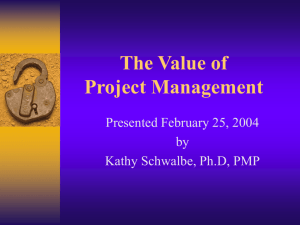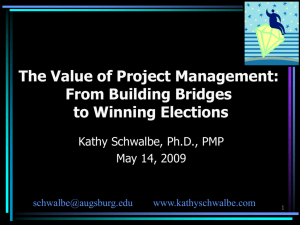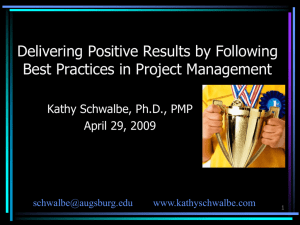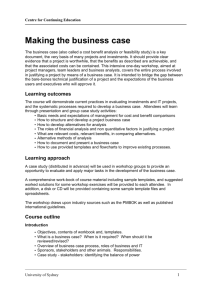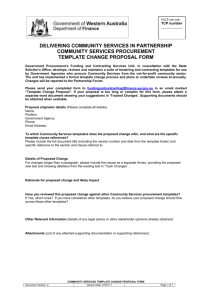Using Technology to Promote Teamwork for Student Projects
advertisement
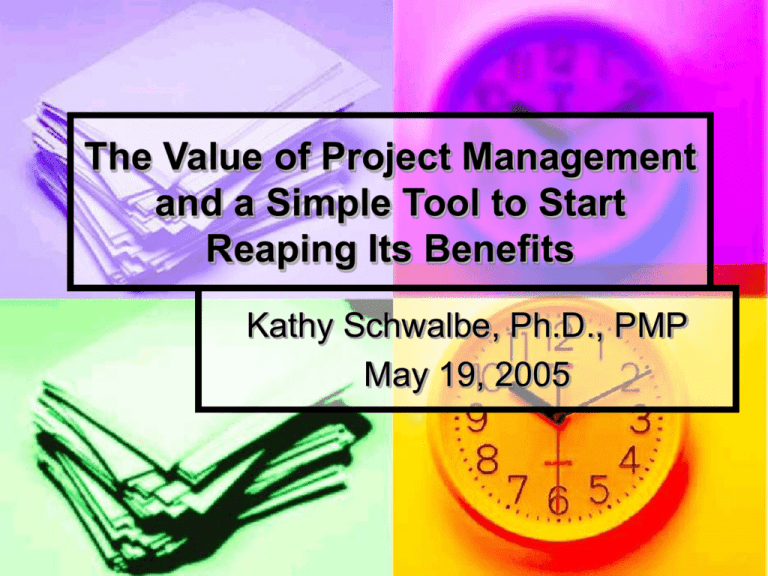
The Value of Project Management and a Simple Tool to Start Reaping Its Benefits Kathy Schwalbe, Ph.D., PMP May 19, 2005 Presentation Outline What is project management? Recent statistics Ways to measure the value of project management Using templates to improve project management Lots of resources What Is Project Management? Project management is “the application of knowledge, skills, tools and techniques to project activities to meet project requirements” (PMBOK ® Guide 2004, p. 8) Project Management Framework* *This figure and others are from my book, Information Technology Project Management, Fourth Edition Standish Group Statistics* Measure Successful projects Failed projects Money wasted on challenged and failed projects 1994 Data 16% 31% $140 B out of $250 B 2002 Data 34% 15% $55 B out of $255 B Result Doubled Halved More than halved *The Standish Group, “Latest Standish Group CHAOS Report Shows Project Success Rates Have Improved by 50%,” (March 25, 2003) Some Interesting Statistics The U.S. spends $2.3 trillion on projects every year, or one-quarter of its gross domestic product, and the global percentage is similar (PMI Project Management Fact Book, 2001) In 2003, the average senior project manager in the U.S. earned almost $90,000 per year, and the average Project Manage Office (PMO) Director earned more than the average Chief Information Officer ($118,633 vs. $103,925) (PMI Project Management Salary Survey, 2003) Top Information Technology Skills 70% 60% 60% Percentage of Respondents 58% 50% 42% 41% Database management Networking 40% 30% 20% 10% 0% Application development Project management Information Technology (IT) Skill Cosgrove, Lorraine. “January 2004 IT Staffing Update,” CIO Research Reports, (February 3, 2004). Growth in PMP Certification, 1993-2004 102,047 100,000 # PMPs 80,000 76,550 60,000 52,443 40,343 40,000 27,052 20,000 - 18,184 1,000 1993 1,900 1994 2,800 1995 4,400 1996 6,415 1997 10,086 1998 1999 Year 2000 2001 2002 2003 2004 Ways to Measure Project Management Value Agreement on general benefits Improved project performance/results ROI of project management PM maturity levels Competitive advantage What the winners do/best practices General Benefits of Project Management Better control of financial, physical, and human resources Improved customer relations Shorter development times Lower costs Higher quality and increased reliability Improved productivity Better internal coordination Higher worker morale (less stress) Improved Project Performance* Project success is often based on meeting project scope, time, and cost goals Measure Successful projects Failed projects Money wasted on challenged and failed projects 1994 Data 16% 31% $140 B out of $250 B 2002 Data 34% 15% $55 B out of $255 B Result Doubled Halved More than halved *The Standish Group, “Latest Standish Group CHAOS Report Shows Project Success Rates Have Improved by 50%,” (March 25, 2003) Why the Improvements? "The reasons for the increase in successful projects vary. First, the average cost of a project has been more than cut in half. Better tools have been created to monitor and control progress and better skilled project managers with better management processes are being used. The fact that there are processes is significant in itself.“* *The Standish Group, "CHAOS 2001: A Recipe for Success" (2001) What Helps Projects Succeed?* 1. 2. 3. 4. 5. 6. 7. 8. 9. Executive support User involvement Experienced project manager Clear business objectives Minimized scope Standard software infrastructure Firm basic requirements Formal methodology Reliable estimates *The Standish Group, "CHAOS 2001: A Recipe for Success" (2001) Improvements to Key IT Project Metrics Due to Project Management* C Sc he du St u ra st l e o e te gi me stim c bu r sa at si tis ing n f C os ess act t/h al ion or ign s es me T S c im tim nt e he a du and tin g le b pe ud La rfo ge bo rm t rh an ou ce rs Q pe ua C r os fo lity t p rm er an f R orm ce es a St pon nce af f p se t ro im e d Ti m uct e i to v ity m ar ke t % Improvement 45 38.6 37.6 37 40 32.8 32.5 32.1 31.9 35 30 25.6 23.8 23 22.8 21.7 25 20 15 10 5 0 *Value of Project Management in IT Organizations survey,Center for Business Practices, 2002, cited in PM Network, July 2003, p. 16 Findings From 5-Year Study on Quantifying the Value of PM* Companies with more mature project management practices have better project performance (on time and budget vs. 40% over time and 20% over cost targets) PM maturity is strongly correlated with more predictable project schedule and cost performance (i.e. .08 schedule performance index variation vs. .16) Good PM companies have lower direct costs than poor PM companies (6-7% vs. 11-20%) *Ibbs, William and Justin Reginato, Quantifying the Value of Project Management, PMI (2002) Project Management ROI* Over 94% of senior PM professionals say that implementing PM added value to their organizations Formula to predict increased company ROI based on increased PMM level Determine cost to improve PMM level, improvement in cost performance index (CPI), then calculate PM ROI using profit margins and projected annual revenues *Ibbs, William, “The $$$ Value of Project Management: Continuing the Search for PM’s ROI,” PDS ’02 Conference Proceedings, PMI-ISSIG http://www.ce.berkeley.edu/pmroi/PMROI%20PMI%20Presentation%20 Feb2001.pdf PM ROI Example* Company initially has PMM of 2.3, CPI of .71, profit margin of 5% , $10 M projected annual revenues Company improves PMM to 3.1, CPI to .94, profit margin to 6.6% at a cost of $400,000 PM ROI = (6.6%-5.0%)X$10,000,000 = 40% $400,000 *Ibbs, William, “Managing Chaotic Projects: Improving your PM/ROI” (http://www.ce.berkeley.edu/pmroi/ PMROI%20PMI%20Presentation%20Feb2001.pdf) Project Management Maturity Models Similar to maturity models for improving software like the Capability Maturity Model (CMM or now CMMI) Several PM firms have their own maturity models, most using levels 1-5 The International Institute for Learning, Inc. calls the five levels common language, common processes, singular methodology, benchmarking, and continuous improvement PMI’s Organizational Project Management Maturity Model (OPM3) released their model in 2004 Berkeley Project Management Process Maturity Model Sample PMM Assessment Questions* *www.ibbsconsulting.com Project Management Maturity by Knowledge Area and Industry Feedback from Bill Ibbs* We've benchmarked a couple healthcare organizations…what I can say is that the IT PM capability of those organizations was poor, especially in terms of initiating projects. We helped one of those companies save several million dollars over a 2 year period by helping them focus better on the projects they launched.” Wall Street reports that the healthcare industry in general is gearing up to spend even more $$$ on IT in the next couple years than they have in the past. So there's a lot at stake.” * From e-mail correspondence Feb. 2, 2004 Other Research Suggests That PM Maturity Models Only Measure Explicit Knowledge* Explicit knowledge: “know what,” can be put into IT, a digital or discrete process that can be codified and transmitted in formal, systematic language (Nonaka 1994) Tacit knowledge: “know how”, in one’s experience; hard to replicate and can be transferred indirectly though time consuming socialization processes (Kaplan et al 2001) *Jugdev and Thomas, “Blueprint for Value Creation: Developing and Sustaining a Project Management Competitive Advantage Through the Resource Based View,” Proceedings of PMI Research Conference, 2002 Need to Make PM a Strategic Asset (Just Like IT) Many executives view project management as having worth at the operational and tactical rather than strategic level Resource Based View (RBV) frameworks emphasize how firms create value and profits from their internal resources and focus on strategic assets RBV is relevant to project management because it emphasizes intellectual capital Research Based View Model* high Social Capital Strategic Assets Know How PM Maturity low Know What low high Need to combine know what with know how to make PM a strategic asset! *Jugdev, Kam, presented at PMI Research Conference, July 2002 Successful Examples of Applying PM in Healthcare Organizations Theory of Constraints aids in scheduling Good project managers are critical to successful drug launches Applying the Theory of Constraints (TOC) in Health Care* TOC is a form of systems thinking that suggests that any complex system at any point in time often has only one aspect or constraint that limits its ability to achieve more of its goal. Need to exploit constraint and adjust scheduling and resource usage A USAF base decreased waiting time for primary care appointments from 17 days to 4.5 at no additional cost Radcliff Infirmary in Oxford, England improved waiting times for neurosurgery and ophthalmology (noted a 100% reduction in elective cancellations and increases in throughput of over 16% at no additional cost) *Breen, Anne, Tracey Burton-Houle, and David C. Aron, “Applying the Theory of Constraints in HealthCare: Part 1 – The Philosophy,” Quality Management in Health Care, (Vol 10, Number 3), Spring 2002, www.goldratt.com/for-cause/applyingtocinhcpt1fco.htm Pharmaceutical Project Managers Are a Breed Apart* Significant investments in drug development projects (12 years and $800M on average), the magnitude of risks in the development cycle, and extensive involvement of senor management makes it especially tough being a PM in this industry “I know of no pharmaceutical company today attempting drug development without a project manager to oversee it” (Luis Cabassa, PMP, Genetech Inc.) Pappas, Lorna, “The Right Prescription,” PM Network, October 2002 “What the Winners Do”* Companies that excel in project delivery capability: Build an integrated project management toolbox (use standard and advanced PM tools, lots of templates) Grow competent project leaders, emphasizing business and soft skills Develop streamlined, consistent project delivery processes Install a sound but comprehensive set of project performance metrics *Milosevic, Dragan, Portland State University, “Delivering Projects: What the Winners Do,” PMI Conference Proceedings, November 2001 Using a Standardized Project Management Approach* Research found that a consistent (one-size-fits-all) managerial approach may be essential to the successful standardization of certain aspects of project management, and a contingency approach is needed for certain aspects, too Low standardization with a sufficient amount of variation is the more appropriate approach *Milosevic and Pantanakul, “The Impact of Standardized Project Management: New Product Development Projects versus Software Development Projects,” Proceedings of PMI Research Conference 2002 What Are Templates? Templates are documents or files that provide an outline or format for creating documentation Many professionals don’t like to write or ask others how to do “simple” things, and no one likes to reinvent the wheel Templates make it easier to prepare common project documents and use standard tools and techniques It’s important to tailor templates to unique project and organizational needs Sample Templates Information Technology Project Management, Fourth Edition, includes 38 templates used in the book information for accessing 333 free templates from other sources You can access all of these template files for free from www.kathyschwalbe.com www.kathyschwalbe.com Template Files Breakeven Template Business Case Financials Template Financial Analysis for Project Name Created by: Date: Note: Change the inputs, such as interest rate, number of years, costs, and benefits. Formulas are entered in the Excel file used to create this template. Be sure to double-check the formulas Discount rate 8% Assume the project is completed in Year 0 Year Costs Discount factor Discounted costs 0 100 1.00 100 1 100 0.93 93 2 100 0.86 86 3 Total 100 0.79 79 358 Benefits Discount factor Discounted benefits 0 1.00 0 200 0.93 185 200 0.86 171 200 0.79 159 Discounted benefits - costs Cumulative benefits - costs (100) (100) 93 (7) 86 78 79 158 ROI Assumptions Enter assumptions here 44% Payback before Year X 515 158 NPV Project Charter Project Title: Project Start Date: Budget Information: Projected Finish Date: Project Manager: Name, phone, e-mail Project Objectives: Approach: Roles and Responsibilities Role Name Organization/ Position Contact Information Sign-off: (Signatures of all above stakeholders. Can sign by their names in table above.) Comments: (Handwritten or typed comments from above stakeholders, if applicable) Gantt Chart Template Weighted Decision Matrix for Project Name Created by: Criteria A B C D E F G Weighted Project Scores Date: Weight Project 1 Project 2 Project 3 Project 4 25% 90 90 50 20 15% 70 90 50 20 15% 50 90 50 20 10% 25 90 50 70 5% 20 20 50 90 20% 50 70 50 50 10% 20 50 50 90 100% 56 78.5 50 41.5 Weighted Score by Project Project 4 Project 3 Project 2 Project 1 0 20 40 60 80 100 Student Project Results: Free Template Distribution by Process Group and Knowledge Area Knowledge Area Project Process Groups Initiating Executing Controlling 15 7 30 52 23 12 70 Time 10 8 18 Cost 14 4 18 Quality 11 14 5 30 Human Resources 13 4 Communications 12 11 Risk 38 Procurement 4 1 140 37 Integration Scope Total 35 35 Closing Total Planning 17 35 15 12 106 73 50 0 5 15 333 Students’ Top Ten Free Template Sites Number of Free Templates 22 28 Resource Name and URL Michigan Department of Information Technology: http://www.michigan.gov/dit/0,1607,7-139-7321_18457-45013--,00.html Minnesota Office of Technology: http://www.state.mn.us/cgi-bin/portal/mn/jsp/content.do?subchannel=-536879888&id=-8484&agency=OT 23 New York State Office for Technology: 12 Tasmanian State Government: 28 U.S. Department of Energy: 52 http://www.oft.state.ny.us/pmmp/templates/index.htm http://www.projectmanagement.tas.gov.au/index.htm http://cio.doe.gov/ITReform/sqse/pm_main.htm University of Waterloo Information Systems & Technology: http://ist.uwaterloo.ca/projects/templates.html 12 Method 123: http://www.method123.com 19 ProjectWare: http://www.projectware.com.au/pw030.html 14 8 State of Texas Department of Information Resources: http://www.dir.state.tx.us/eod/qa/template.htm U.S. Defense Logistics Agency: http://www.dsioj.dla.mil/spi/template/pm-tmp.htm Complete details are available from the Tempting Templates web site: http://webpages.charter.net/hafox/pm/docs/TemptingTemplatesPreliminaryReport.htm Kathy’s Observations on Templates In early 2003 I added templates to my Web site for project proposals, team contracts, and scope statements, and the quality of student projects improved tremendously People like to have more guidance on expectations and formats for various project documents, and they want the actual files to make their jobs easier Be sure the templates are useful and not just bureaucratic paperwork, and be sure people use them properly Resources The text book Web site for my third edition is available for free at www.course.com/mis/schwalbe Fourth edition Web site is password protected (need to buy the book!) – includes guide to using Project 2002 and 2003, interactive test questions, updated lecture slides, links to hundreds of references, etc. Lots of info from my site Questions? Feel free to use templates, teaching ideas, etc. from my Web site at www.kathyschwalbe.com. Contact me at schwalbe@augsburg.edu.
